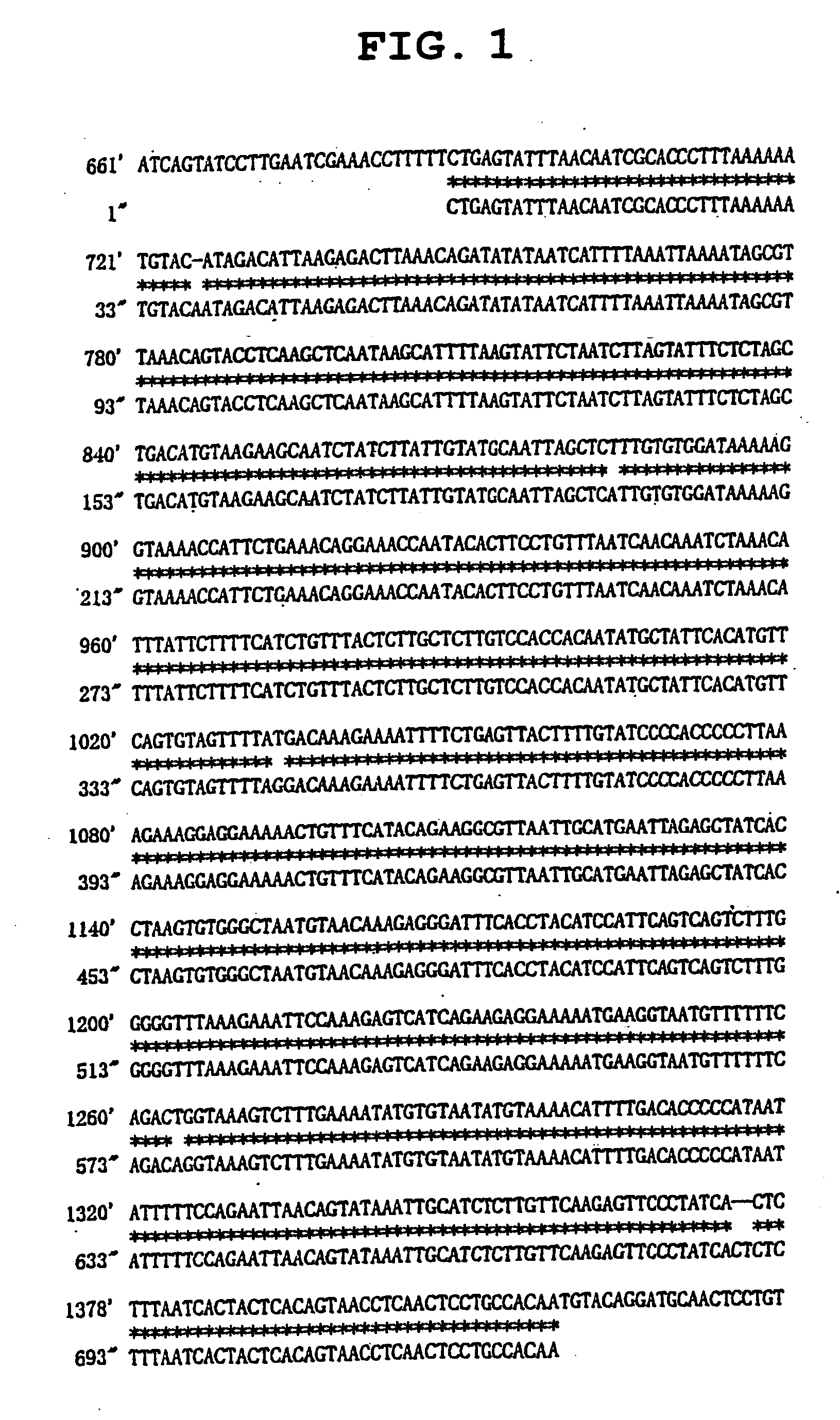Method of selecting novel immunosuppressant
a immunosuppressant and immunosuppressant technology, applied in the field of immunosuppressant selection, can solve the problems of difficult to use such compounds as actual therapeutic drugs, difficult to suppress the immune system, and the effect of reducing platelet coun
- Summary
- Abstract
- Description
- Claims
- Application Information
AI Technical Summary
Benefits of technology
Problems solved by technology
Method used
Image
Examples
example 1
Construction of Reporter Gene Plasmids for IL-2 Reporter Gene Assay
[0136] A 728-basepair fragment corresponding to the −674 to +54 region in the vicinity of the transcription initiation site of the human IL-2 gene was obtained by the PCR method with a genomic DNA isolated from Jurkat cells derived from human T cell (ATCC, TIB-152) as a template. PCR was performed using the primers shown by SEQ ID NO:27 and SEQ ID NO:28 below. These primers were designed on the basis of the human IL-2 gene sequence listed as Locus code: HSIL05 in the gene database GenBank. Additionally, a restriction endonuclease recognition site was added to the end of each primer to insert to a vector for reporter gene assay. The 728-basepair fragment obtained has an NheI recognition site upstream of the promoter, and a HindIII recognition site downstream of the promoter. The amplified 728-basepair fragment was inserted to the cloning vector pCR4 (manufactured by Invitrogen). Subsequently, the base sequence of the...
example 2
Construction of Reporter Gene Plasmids for GATA-1 Reporter Gene Assay
[0138] An 821-basepair fragment corresponding to the −789 to +32 region in the vicinity of the transcription initiation site of the human GATA-1 gene was obtained by the PCR method with human genomic DNA as a template. PCR was performed using the primers shown by SEQ ID NO:32 and SEQ ID NO:33 below. These primers were designed on the basis of the human GATA-1 gene sequence listed as gene database GenBank accession number AF196971. Additionally, a restriction endonuclease recognition site was added to the end of each primer to insert to a vector for reporter gene assay. The 821-basepair fragment obtained has a BglII recognition site upstream of the promoter, and a HindIII recognition site downstream of the promoter. The amplified 821-basepair fragment was inserted to the cloning vector pCR4. Subsequently, the base sequence of the inserted region in the plasmid obtained (SEQ ID NO:25) was confirmed. As a result, the...
example 3
3.1. Construction of Plasmids for Subcloning of HDAC1 to 8
[0140] Using the templates and primers shown in Table 1, various full-length HDAC isozymes were amplified by PCR and once subcloned into pGEM-T (Promega). Subsequently, each of full-length HDAC1 to 6 was inserted to pBluescriptII KS(+) (TOYOBO) via treatment with a restriction endonuclease (EcoRI / NotI for HDAC1, BamHI / NotI for HDAC2, EcoRI / NotI for HDAC3, EcoRI / NotI for HDAC4, HindIII / NotI for HDAC5, HindIII / NotI for HDAC6). Each of full-length HDAC7 and 8 was subcloned into pUC18 (TaKaRa) (SmaI treatment). For details, see Table 1.
TABLE 1Preparation of subcloning plasmid of HDAC1-8Template foramplifying aGenBankSize ofName ofHDACfull-length Sequences of a pair of primers for amplifyingaccessionPCRplasmidisozymeHDACa full-length HDACnumber1)product2)prepared3)HDAC1Jurkat T-HDAC1-E:D50405about 1.5pMH107cell cDNAGAGGAATTCAAGATGGCGCAGAC(SEQ ID NO:36)kbplibraryHDAC1-N:(Clontech)GGAGCGGCCGCTTCAGGCCAACTTG(SEQ ID NO:37)HDAC2Human...
PUM
| Property | Measurement | Unit |
|---|---|---|
| pH | aaaaa | aaaaa |
| pH | aaaaa | aaaaa |
| pH | aaaaa | aaaaa |
Abstract
Description
Claims
Application Information
 Login to View More
Login to View More - R&D
- Intellectual Property
- Life Sciences
- Materials
- Tech Scout
- Unparalleled Data Quality
- Higher Quality Content
- 60% Fewer Hallucinations
Browse by: Latest US Patents, China's latest patents, Technical Efficacy Thesaurus, Application Domain, Technology Topic, Popular Technical Reports.
© 2025 PatSnap. All rights reserved.Legal|Privacy policy|Modern Slavery Act Transparency Statement|Sitemap|About US| Contact US: help@patsnap.com



